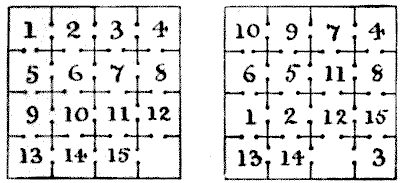
THE SPANISH DUNGEON.—solution

This can best be solved by working backwards—that is to say, you must first catch your square, and then work back to the original position. We must first construct those squares which are found to require the least amount of readjustment of the numbers. Many of these we know cannot possibly be reached. When we have before us the most favourable possible arrangements, it then becomes a question of careful analysis to discover which position can be reached in the fewest moves. I am afraid, however, it is only after considerable study and experience that the solver is able to get such a grasp of the various "areas of disturbance" and methods of circulation that his judgment is of much value to him.
The second diagram is a most favourable magic square position. It will be seen that prisoners 4, 8, 13, and 14 are left in their original cells. This position may be reached in as few as thirty-seven moves. Here are the moves: 15, 14, 10, 6, 7, 3, 2, 7, 6, 11, 3, 2, 7, 6, 11, 10, 14, 3, 2, 11, 10, 9, 5, 1, 6, 10, 9, 5, 1, 6, 10, 9, 5, 2, 12, 15, 3. This short solution will probably surprise many readers who may not find a way under from sixty to a hundred moves. The clever prisoner was No. 6, who in the original illustration will be seen with his arms extended calling out the moves. He and No. 10 did most of the work, each changing his cell five times. No. 12, the man with the crooked leg, was lame, and therefore fortunately had only to pass from his cell into the next one when his time came round.
click here to go to my blog.
See more interesting puzzles at http://puzzles.50webs.org